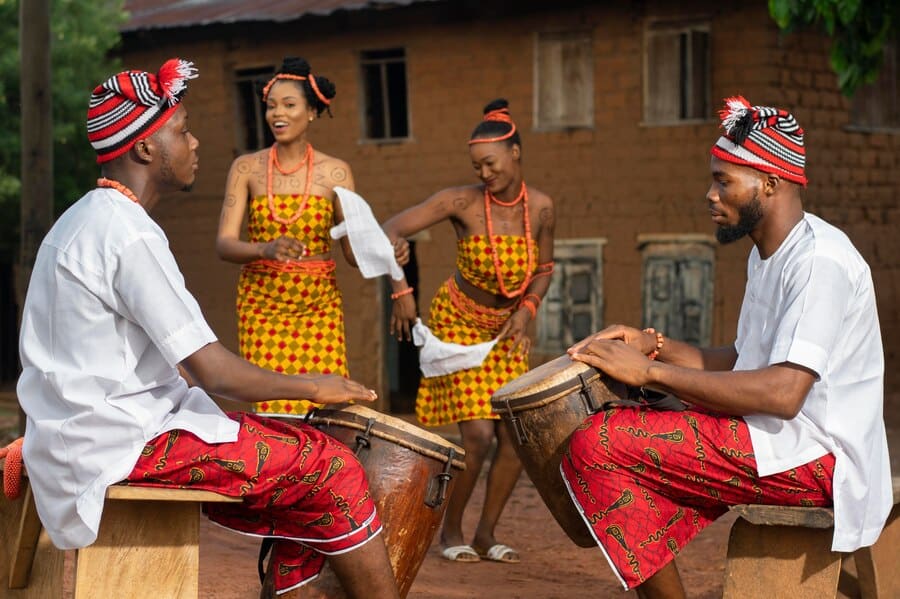
The Vibrant World of African Music and Dance: Dive into the Rhythm and Soul
I sit here, tapping my foot to an infectious beat and swaying to captivating melodies. It’s like I’m in the heart of Africa, feeling the primal energy. The rhythmic pulsations and dances pull me in deep.1 This is the alluring world of African music and dance, blending diverse cultures, lively rhythms, and spirit-moving steps.
Africa’s culture is a mix of rich rhythms and movement. Every dance and music style shows the continent’s varied traditions.1 There’s the joyous Kiganda dance, the powerful Acholi warrior dance, and the Bamasaba’s Imbalu rite. These dances share stories of community and human experience.1

The core of this vibrant world is African music’s pulsating heartbeat. It’s a mix of drums, percussion, and melodies that paint a sound picture.2 The adungu and akogo are just some of the instruments that create these sounds. Each instrument shows a bit of Africa’s culture.
Key Takeaways
- African music and dance are a vibrant tapestry of diverse cultural traditions, rhythms, and movements.
- Traditional African dance forms, such as the Kiganda, Acholi, and Imbalu dances, are powerful expressions of community, spirituality, and the human experience.
- The rhythmic foundation of African music is shaped by a wide range of traditional instruments, including drums, xylophones, and stringed instruments like the kora and ngoni.
- African music often incorporates complex polyphony, microtones, and call-and-response patterns, creating a distinctive and captivating sound.
- Contemporary African music and dance continue to evolve, blending traditional styles with modern techniques and influences.
The Rich Cultural Heritage of African Music and Dance
African music and dance have a long history that shows the continent’s rich culture.1 Dance explains stories and feelings, showing community, spiritual beliefs, and life itself.3
Diversity in Rhythm and Movement
Vibrant rhythms and flowing movements are key in many African dances, like Kiganda, Acholi, and Imbalu.1 These dances have changed over time, showing how creative and adaptable people can be.1
Storytelling through Dance
African dances range from rituals and rites of passage to casual social events.1 The harder a dance shows a big idea, the more people enjoy it and the better they expect the dancers to be.3 Dances like jazz and hip hop mix African and European styles, adding new flavors.1
Music as a Communal Experience
Music in Africa connects people deeply, used for fun, joining together, and passing stories.3 Dances in African communities vary but always have a main goal, sharing important values and relationships.3
Traditional African Dance Forms
The variety of traditional African dance forms shows the continent’s cultural breadth and creativity. For example, the Kiganda dance brings joy to the Baganda tribe, while the Acholi dance honors its warrior heritage. At the same time, the Imbalu dance marks key passages for the Bamasaba. These dances are more than performances. They are the heartbeats of African culture and community.
Kiganda Dance: Joyous Celebration of the Baganda Tribe
The Kiganda dance from the Baganda tribe is filled with vibrant energy and color.4 Dancers move in circles, showcasing their tribe’s rich heritage and unity.3 This dance isn’t just for show. It tells the tribe’s story and captivates everyone with its beauty and meaning.
Acholi Dance: Depicting the Warrior Culture
The Acholi dance stands in stark contrast, highlighting the tribe’s warrior past.4 Dancers act out battle scenes, showing off their strength and courage.3 This dance isn’t just about performance. It blends celebration and tradition, bringing the community together through their shared history and spirit.
Imbalu Dance: A Rite of Passage for the Bamasaba
The Imbalu dance is vital to the Bamasaba as it signifies young men’s coming of age.4 This transition ritual is essential, tying their past to their future.3 The dance keeps their cultural link with the afterlife strong, reinforcing their beliefs through their ceremonies.
Instruments and Rhythms that Shape African Music
The soul of African music beats in the drums. They are known as the “heartbeat of Africa.” These drums, like the ngalabi and akadinda, bring a primitive energy. It grabs the attention of everyone around, whether they are listeners or dancers.2 Drums are not alone in this. They work with other percussion instruments to build the base of African music. This makes the music’s soundscape full of life and variety.2
The Heartbeat of Africa: Drums and Percussion
African music loves its polyrhythms, which are complex rhythms that play together. This creates a rich, layered sound.2 In African music, drums are key. So are other percussion instruments, including xylophones, marimbas, and bells.2 You can hear polyrhythms across Africa. For example, listen to the Yoruba drumming in Nigeria to experience its variety.2
Melodic Instruments: Adungu, Akogo, and More
Not only do drums define African music, there’s also a wide range of melodic instruments to enjoy. The adungu, for instance, plays sweet melodies. And the akogo, a thumb piano, creates mesmerizing tunes.2 Traditional African instruments cover many families, including drums, xylophones, and string instruments like the kora. There are also wind and electronic instruments to add even more colors.2

Vocal Traditions and Harmony in African Music
African music is full of beautiful vocal traditions. These traditions make its sound stand out.2 Many songs have several layers of singing that blend perfectly.
They do this by singing back and forth, with one group leading and the other responding.2 To mix things up, they use sounds that don’t have a meaning but add to the beat or melody.2
Every part of Africa has its special way of singing.5 In some places, many sing together in tune, creating a power in their voices. In other areas, each voice sings a little differently, making the song complex and interesting.5 These differences are what make African music so rich and varied.25
Related read: African-cinema-and-film-industry-explore-the-vibrant-world





